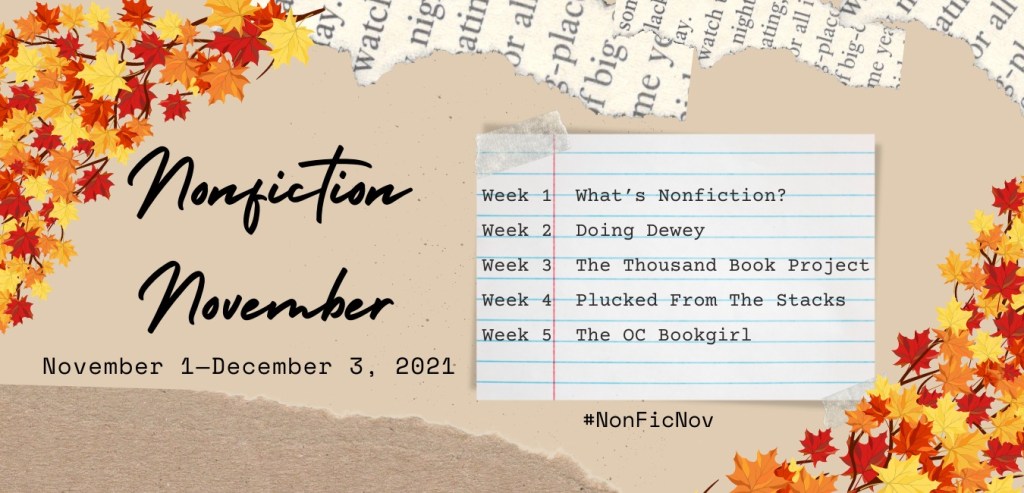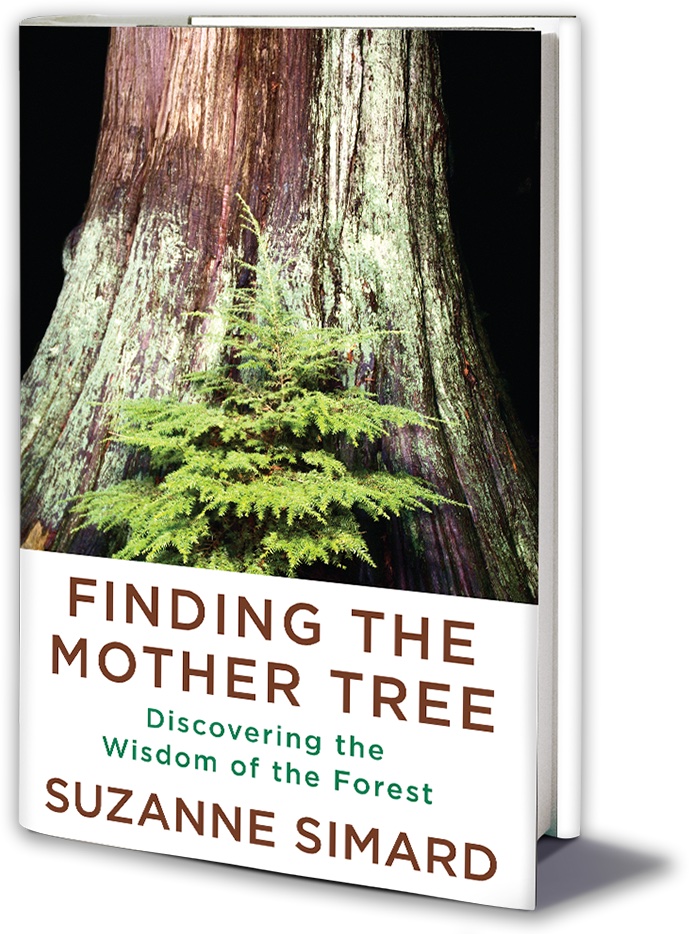
It’s Week 2 of Nonfiction November, hosted by Katie @ Doing Dewey. And the topic is:
This week, pair up a nonfiction book with a fiction title. It can be a “If you loved this book, read this!” or just two titles that you think would go well together. Maybe it’s a historical novel and you’d like to get the real history by reading a nonfiction version of the story.
This one almost writes itself. I’m going to pair my favorite book of 2021 (so far), Finding the Mother Tree by Suzanne Simard (my review) with The Overstory by Richard Powers (my review).


Finding the Mother Tree
As I said in my Week 1 post, Finding the Mother Tree will forever change how you think about forests and what goes on in the ground beneath them.
The author, Dr. Suzanne Simard, is a Professor of Forest Ecology at the University of British Columbia. She has published over 200 peer reviewed papers focused on how trees communicate using below-ground fungal networks. Through these networks they help and support each other. It sounds surreal, but Simard shows how trees form interdependent communities similar in many ways to human communities, cooperating, sharing resources, nurturing their young.
The book is part memoir, part research. It’s beautifully written. Simard takes paragraphs to describe a handful of earth and pages to describe some of her experiments. The book moves slowly. Sometimes it’s hard to detect any movement at all, especially when she’s trying to convince government bureaucrats to change forest management policies. Yet it’s not boring. On the contrary, I found it incredibly interesting.
At some point I realized Simard was telling her story at a tree’s pace.
Connectedness is the central message of Finding the Mother Tree. Like many environmentalists, Simard urges us to stop thinking of the environment as something separate and apart from ourselves, just a resource to be exploited. We humans are part of the environment, embedded within it. We need to learn from the trees.
The Overstory
Dr. Simard’s work was one of the inspirations behind Richard Powers’s novel The Overstory, and one of the characters in the novel is loosely based on her too.
A simple description of The Overstory is that it’s a novel about nine people and their relationships with trees. It’s an unusual novel for sure.
At one level, the book is about these people, about how their life stories evolve, twist, and branch, about how some of them intersect and become entwined with each other both heroically and tragically. And it is about how each of them develop relationships with trees over the course of their lives.
At another level, it’s about the trees themselves: chestnut, mulberry, elm, gingko, Douglas fir, and especially California redwood. These trees are also central characters in the novel. It’s about their lives, their histories, and their relationships with each other and with us.
I think Powers is trying to do something really important and wonderful with this book. He’s trying to broaden our understanding of story to be about more than just humans in conflict. He’s trying to include the natural world – represented here by trees – as integral characters in the story.
Powers too is saying that we must stop looking at the environment solely in terms of how it might be useful to humans. “Useful is the catastrophe,” one of the characters says to herself.
The Overstory might be a new kind of novel, one fit for our time, a powerful story that helps us reintegrate ourselves into the natural world before it’s too late
* * *
I read nonfiction because I want to understand. I want to understand how things work, and what’s going on, and why things are the way they are, and most importantly, what we should do to change things for the better. But I know that nonfiction isn’t for everyone. As one of Powers’s characters says in The Overstory:
“The best arguments in the world won’t change a person’s mind. The only thing that can do that is a good story.” [p. 488]
Whatever works.
Thanks for reading.
Discover more from Unsolicited Feedback
Subscribe to get the latest posts sent to your email.

You’re really making the case for Finding the Mother Tree! Have you read Michael Christie’s Greenwood? I haven’t read it myself, I’ve heard really good things and I think it might be a good addition to your pairing here!
LikeLiked by 1 person
Well it was such an obvious pairing. 🙂
I haven’t read Greenwood but it does look interesting and certainly fits with the other two. Thanks for the recommendation!
LikeLiked by 1 person
Thank you for sharing the connection between these two titles.
LikeLiked by 1 person
That’s a great pair, nice one! I read a lot of fiction as well as nonfiction for those reasons, some fiction for just light relief but my two pairings have a fiction book that I learned a lot from.
LikeLiked by 1 person
Thanks! You’re pair about Gambia looks great too.
LikeLiked by 1 person
The Overstory has been waiting on my shelf for over a year. Great idea to pair it with Finding the Mother Tree.
LikeLiked by 1 person
I hope you enjoy it.
LikeLike
This is a great pairing and both books I’d like to get to! I’ve read a few articles about how forests are really great interconnected webs and that’s something I’d like to learn more about.
LikeLiked by 1 person
Yes, that’s what I found so fascinating too. I hope you get the chance to read one or both of these.
LikeLike
Powers was recently invited to the famous French literary weekly tv program La Grande Librairie, I so need to read him finally. Plus so many great recent nonfiction books on trees, like this one!
Here is my post: https://wordsandpeace.com/2021/11/08/nonfiction-november-2021-book-pairings/
LikeLiked by 1 person
You’ve completely sold me on Finding the Mother Tree. Snagging a copy soon!
LikeLiked by 1 person
I hope you enjoy it!
LikeLiked by 1 person
Pingback: Week 5 - Nonfiction November #theOCBookGirl #nonficnov #nonfictionbookparty - The OC BookGirl
Pingback: Nonfiction November- Week 5: New to your TBR – Still Life, With Cracker Crumbs..
“At some point I realized Simard was telling her story at a tree’s pace.”
What a good way of putting it!
I’ll have to check out The Overstory, soon
LikeLiked by 1 person
Both are great books!
LikeLiked by 1 person